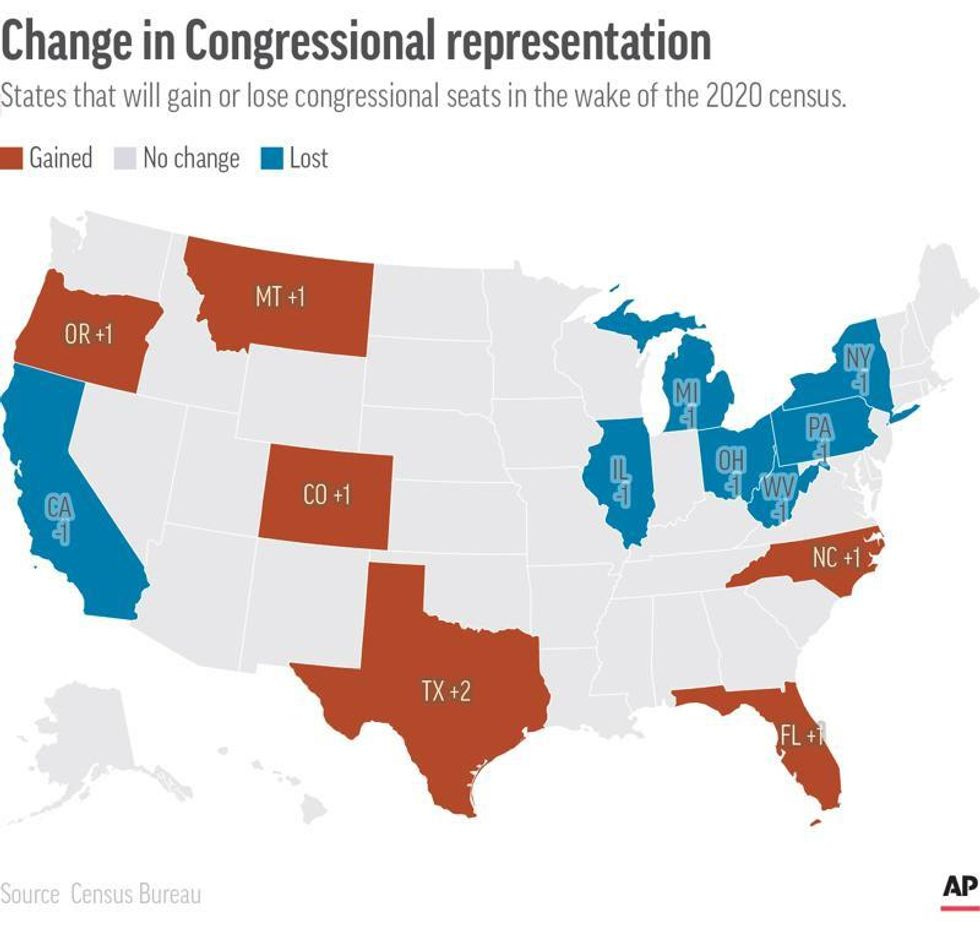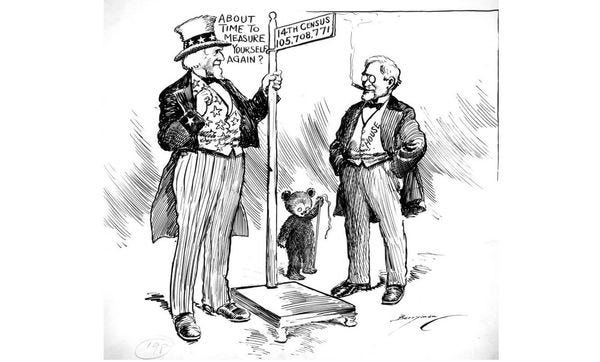Census Results Only Horrible-ish. Nice ... Time?
We don't yet know how Trump may have screwed things up, natch.
After months of delays, mostly due to the pandemic, the US Census released its first data chunks from the 2020 count of the US population yesterday, delivering the state population counts that will be used to reapportion seats in the House of Representatives. The big surprise in the data is that the US population grew at its lowest rate since the 1930s , increasing just 7.4 percent since the 2010 Census. There are now 331,449,281 of us, at least officially, and since the first Census in 1790, that's the second-lowest population increase ever.
As the Brookings Institution points out, that's just a teensy bit more than the 7.3 percent increase during the Great Depression, and "roughlyhalf the 13.2% growth rate of the 1990s, when immigration was highand thelast part of the millennial generation was born."
Politically, the state-by-state population shifts means seven seats in the House will be moving, mostly from the Northeast to the Sun Belt, as this handy-dandy map from the Associated Press shows:

be
Considering that some experts had predicted even larger shifts of congressional seats from blue states to states with Republican-leaning voters, this is actually better news than it might have been. Texas is picking up two seats, and one seat each will go to GOP-leaning Florida, Montana, and North Carolina. The other two seats will go to very blue Oregon and purple-y Colorado.
The states that lost seats were Illinois, Michigan, New York, Ohio, Pennsylvania, West Virginia and, for the first time since it was admitted to the Union, California. New York would have kept the seat it lost if just 89 more people in the state had been counted, which illustrates pretty dramatically why the Census matters.
This is also a good place to remember the Trump administration's attempts to skew the count by throwing a citizenship question into the Census, and by trying to exclude non-citizens from the reapportionment data. Both attempts failed; the Supreme Court rejected the citizenship question in 2019 because the administration didn't even try to make up a non-illegal reason for it, and slowdowns caused by the coronavirus pandemic meant that the initial data on reapportionment never got to Trump before he had to leave office. So thanks, deadly pandemic, you were good for something.
But how good are the numbers, given that Trump also ordered the Census to be cut short weeks before its original end date, which almost certainly left people uncounted? As Rachel Maddow discussed last night, we may have to add "a big asterisk" to many of the 2020 Census's findings:
As NPR's Hansi Lo Wang explains, there are some real concerns that an unknown number of folks the Census Bureau has in the past made extra efforts to reach just didn't get included in last year's count.
[For] this census, there are particular concerns that historically undercounted groups, including people of color, immigrants, renters, rural residents, may have been especially undercounted this time around because of the last-minute changes the Trump administration made to the census schedule, cutting short counting. And because it was so hard to reach those households that didn't respond by themselves, by filling out a form on their own, by sending out in-person visits, doorknockers - literally impossible to do in the early months of the pandemic.
We'll get a better sense of that much later this year, Wang noted, when the American Statistical Association releases its regular audit of the Census Bureau's work in June, and again in December when the Bureau itself releases its own estimates of how many people it may have missed, and the probable rates of undercounting by race and ethnicity. But those reports won't affect redistricting. We bet more than 89 people in New York may have been missed, for instance.
The Census Bureau will get its more granular state-level data to the states by August 16, and that data will be used by states to redraw congressional and state legislative districts.
Bloomberg News notes that the delay in getting all the data out could also cause headaches for the 2022 midterms:
The delayed start could create added chaos at the filing deadlines for next year's congressional elections, as incumbents and their challengers won't know which districts they're running for until their campaigns have already started.
For the states that are losing representatives, that's also going to lead to some potentially ugly fights, Wang points out, since they'll have to decide how to get rid of one of their current members of Congress. Seven current members will have to go, either by resigning, running for a different office, or by the states just plain eliminating the districts out from under them. In Ohio, Tim Ryan has already opted to run for the Senate, for instance.
Also too, as the Brookings Institution reminds us, the shift of seven seats also means that some states will gain more clout, and some will lose it, in the Electoral College. But that may not turn out to be the boon to Republicans it sounds like, at least not in the long term, since the demographics of many red states are also changing to favor Democrats, as we saw last year in Georgia. So that could be good news, depending on how much voter suppression red states get away with.
[ Census Bureau / Brookings Institution / NPR / Bloomberg / AP ]
Yr Wonkette is funded entirely by reader donations. If you can, please kick in $5 to $10 a month, for great justice!
Do your Amazon shopping through this link, because reasons .




While some might ask to subscribe to your newsletter, I'm going to accuse you of plagiarizing my newsletter! 😉
Although, mine also includes a column on how we should remove redistricting from the hands of the legislature entirely, and have it done either by non-partisan commissions, or -- much better still -- by software programmed to be non-partisan.
We shouldn't forget, that on official Census Day, April 1, 2020, New York State and New York City was being ransacked and ravaged by the first wave of Covid-19. At that time, a lot of people were fleeing the city and returning back to their original hometowns, plus, the death toll in both State and City was starting to skyrocket. The loss of population in New York State in 2020 was very real. But, I do find the number of 89 more people in order to keep a congressional seat to be a very suspect number, and some person(s) higher up in the last administration cheated with that number so New York State could lose a Congressional Seat and Electoral Vote. All because of a petty feud between Former Dearest Leader and Gov. Cuomo.